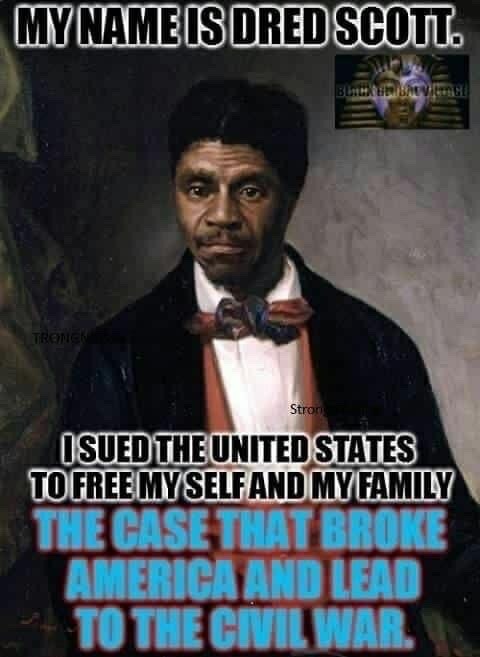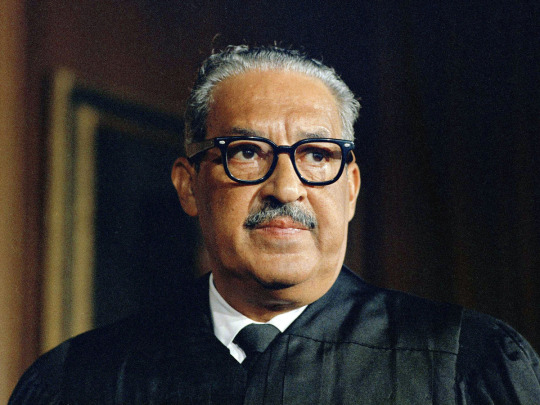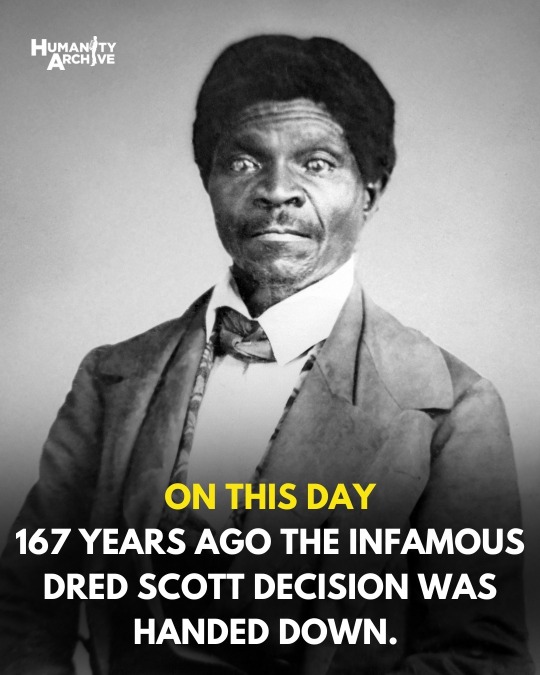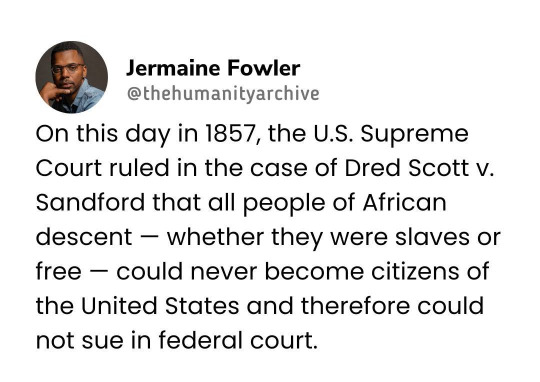#dred scott
Text

This is a gift🎁link so anyone can read the entire NY Times article, even if they don' subscribe to the Times.
Jamelle Bouie does another excellent job of looking at current events through the perspective of American history. In this column, he compares the current Roberts Court with the infamous late 1850s/ early 1860s Taney Court--the Court that lost all credibility with its Dred Scott decision. Below are a few excerpts.
If the chief currency of the Supreme Court is its legitimacy as an institution, then you can say with confidence that its account is as close to empty as it has been for a very long time.
Since the court’s decision in Dobbs v. Jackson Women’s Health Organization nearly two years ago, its general approval with the public has taken a plunge.
[...]
In the latest 538 average, just over 52 percent of Americans disapproved of the Supreme Court, and around 40 percent approved.
[...]
At the risk of sounding a little dramatic, you can draw a useful comparison between the Supreme Court’s current political position and the one it held on the eve of the 1860 presidential election.
[color emphasis added]
[See more below the cut.]
NOTE: Remember that back in the 1850s/1860s the Democrats were the party that supported slavery. The Democrats and Republicans switched positions on civil rights in the late 20th century.
It was not just the ruling itself that drove the ferocious opposition to the [Taney] Supreme Court’s decision in Dred Scott v. Sandford, which overturned the Missouri Compromise and wrote Black Americans out of the national community; it was the political entanglement of the Taney court with the slaveholding interests of the antebellum Democratic Party.
[...]
Five of the justices were appointed by slave owners. At the time of the ruling, four of the justices were slave owners. And the chief justice, Roger Taney, was a strong Democratic partisan who was in close communication with James Buchanan, the incoming Democratic president, in the weeks before he issued the court’s ruling in 1857. Buchanan, in fact, had written to some of the justices urging them to issue a broad and comprehensive ruling that would settle the legal status of all Black Americans.
The Supreme Court, critics of the ruling said, was not trying to faithfully interpret the Constitution as much as it was acting on behalf of the so-called Slave Power, an alleged conspiracy of interests determined to take slavery national. The court, wrote a committee of the New York State Assembly in its report on the Dred Scott decision, was determined to “bring slavery within our borders, against our will, with all its unhallowed, demoralizing and blighted influences.”
The Supreme Court did not have the political legitimacy to issue a ruling as broad and potentially far-reaching as Dred Scott, and the result was to mobilize a large segment of the public against the court. Abraham Lincoln spoke for many in his first inaugural address when he took aim at the pretense of the Taney court to decide for the nation: “The candid citizen must confess that if the policy of the government upon vital questions, affecting the whole people, is to be irrevocably fixed by decisions of the Supreme Court, the instant they are made, in ordinary litigation between parties, in personal actions, the people will have ceased to be their own rulers.”
[color/ emphasis added]
[formatting edited]
#scotus#roberts court#dobbs v. jackson women's health organization#taney court#dred scott#legitimacy of the supreme court#jamelle bouie#the new york times#gift link
103 notes
·
View notes
Text

287 notes
·
View notes
Text

Today In History
Dred Scott was born into slavery in Southampton, Virginia, around 1795, the property of the Peter Blow family. He was given the name “Sam” but took the name of his older brother, Dred, when the latter died.
In 1836, Scott who was approximately 41, married a teenaged slave, Harriett Robinson, at Fort Snelling who was owned by another U.S. Army officer, Major Lawrence Taliaferro of Virginia. Scott and Robinson gave birth to their first child, Eliza, in 1838 and a second daughter, Lizzie, in 1840, and their two children were born free.
In 1843, Emerson died and left his estate to his widow, Irene Sanford Emerson. When Scott offered to purchase his freedom for $300 in 1846, Emerson refused his offer. He then obtained the assistance of two St. Louis attorneys who helped him to sue for his freedom. His 1846 lawsuit was filed in the St. Louis Circuit Court and went to trial in 1847.
Scott lost this case, but later that year he won a second trail. By this point Scott received financial support and legal representation from the sons of Peter Blow, his former owner, who had become anti-slavery advocates, Irene Sanford Emerson’s brother, John Sanford, and her second husband, Dr. C.C. Chaffee, a Massachusetts abolitionist. To all of them the Scott case as an important challenge to slavery.
On March 6, 1857, the United States Supreme Court finally ruled in Dred Scott v Sandford [Sanford was misspelled by a court clerk]. In a 7-2 decision written by Chief Justice Roger B. Taney, the majority of justices said that Scott and all slaves and free blacks were not citizens of the United States and therefore had no standing in the courts. The backlash to this decision strengthened the abolitionist movement and further divided the North and South, leading four years later to the U.S. Civil War.
After he was freed, Dred Scott went to work as a porter in the St. Louis area. He died from tuberculosis in September 1858. Harriett Scott died eighteen years later on June 17, 1876.
CARTER™️ Magazine
#carter magazine#carter#historyandhiphop365#wherehistoryandhiphopmeet#history#cartermagazine#today in history#staywoke#blackhistory#blackhistorymonth#dred scott
83 notes
·
View notes
Text
OK So Context
I kind of progressively lost my mind in college. What with the learning about the specifics of what is going on and how it relates to what has happened in the past. -and subsequently took the time to develop a series of presentations about why the US sucks.
Specifically, the interventions in Latin American, just the astoundingly predatory nature of American Capitalism domestically and The Police, like, as a concept.
Fast forward to the Summer of 2022 and I realized that working with an editor and publishing a book is hard and expensive but its measured in thousands not tens of thousands so I committed to doing that at some point in my life with this project, and began working on adapting the presentations with more research and more connections between these different expressions of White Supremacy.
I let the research balloon. There's just so much.
Anyway, the whole social media campaign thing was to distract me from pinning all that down. -and last month one of the members of my subreddit, u/acebush1, self immolated in the time it took to get around to responding to his most recent comment. That made this all very real. The US' support for Israel and it's foundation as a settler colonial state are critically relevant.
Right, so,. Last month someone asked me how to buy the book and that was the thing I had said to myself would mark the transition back to a writing and research focus rather than just research and learning social media.
Site is up. Its an email submission form with a set your own price stripe link.
#US Authoritarianism Project#Aaron Bushnell#US Politics#protest#writeblr#History#Colonialism#Imperialism#Police#Duopoly#Democracy#republicans#American Fascism#american exceptionalism#Slavery#Jim Crow#Segregation#Mass Incarceration#reservation#deportation#forced migration#sterilization#eugenics#ethnic cleansing#dred scott#japanese internment#guantanamo#trail of tears#US Authoritarianism#Anarchy
6 notes
·
View notes
Text
NPR: Congress votes to remove a bust of the Dred Scott decision's author from the Capitol

The House gave final passage to legislation to replace the bust of Roger Taney, the Supreme Court justice who wrote the Dred Scott decision, in the Capitol with one of Thurgood Marshall, the first Black person to serve on the high court.
The notorious 1857 Dred Scott decision upheld slavery and established that Black people were not U.S. citizens. The legislation, which passed Wednesday and now heads to President Biden's desk, says the bust is "unsuitable for the honor of display to the many visitors to the Capitol."
The statue of Taney sits at the entrance of the Old Supreme Court Chamber in the Capitol where the Supreme Court met from 1810 to 1860. Taney, the fifth chief justice, led the court from 1836 to 1864.
"While the removal of Chief Justice Roger Brooke Taney's bust from the Capitol does not relieve the Congress of the historical wrongs it committed to protect the institution of slavery, it expresses Congress's recognition of one of the most notorious wrongs to have ever taken place in one of its rooms, that of Chief Justice Roger Brooke Taney's Dred Scott v. Sandford decision," the legislation says.
Former Baltimore Mayor Catherine Pugh ordered the removal of four Confederate monuments, including one of Taney, in 2017. Just two days later, Maryland removed another statue of Taney, who also served as the state's attorney general, from State House grounds.
"Taney's ruling denied Black Americans citizenship, upheld slavery, and contributed, frankly, to the outbreak of the Civil War," Rep. Steny Hoyer, D-Md., said on the U.S. House floor on Wednesday. "That's why I and so many others advocated for his statue's removal from the Maryland State House."
Congress has voted to replace Taney's bust at the U.S. Capitol with one of Thurgood Marshall, the first Black associate justice of the Supreme Court. Bob Schutz/AP

Congress has voted to replace Taney's bust at the U.S. Capitol with one of Thurgood Marshall, the first Black associate justice of the Supreme Court.
Bob Schutz/AP
Taney's bust must be removed within 45 days of the enactment of the bill and a bust of Marshall must be obtained within two years, according to the legislation.
"In removing Taney's bust, I'm not asking that we would hold Taney's to today's moral standards," Hoyer said. "On the contrary, let us hold him who the standard of his contemporaries, Harriet Tubman, Frederick Douglass, Abraham Lincoln ... and all of those who understood that the enslavement of others has always been an immoral act."
#american racism#Congress votes to remove a bust of the Dred Scott decision's author from the Capitol#Dred Scott#Thurgood Marshall
1 note
·
View note
Text
American Rot

AMERICAN ROT by Kate Taney Billingsley directed by Estelle Parsons: After two tech-heavy Broadway shows it was refreshing to go to La Mama, sit on a folding chair and watch a play where the only scenery that moved was chairs as the actors adjusted positions. Billingsley has tackled a tremendous topic, the different viewpoints and experiences of black and white Americans. She can’t possibly present every aspect of the issue, but it’s amazing how deftly she covers a great deal. A descendant of Dred Scott (Leland Gantt) drives to a New Jersey coffee house to meet with a descendant of the Supreme Court justice (Timothy Doyle) who decided that slaves were not intended to have the same rights as citizens, even in free states. The white man (John L. Payne) wishes to apologize and present the black man (Court Stovall) with a gift, the chief justice’s gavel. Not a good choice. This triggers a debate, with members of each man’s family weighing in on racial tensions (even though they’re not physically present at the meeting) and contributions from the MAGA waitress (Suzanne Di Donna) and a Latinx cook (Francisco Solorzano), who keeps writing ironic specials on the board like “Rape and Pillage Happy Hour” and “Cage-Free Children.” There’s a great deal of humor in the play, and under Parsons’ direction the timing is expert. There are also choral moments that land powerfully along with a funny title song performed by the chorus. Lest you think the play is all about excoriating the white liberal’s unacknowledged prejudice, there’s also a powerful scene in which Dred Scott excoriates his descendant for claiming a pain he never experienced. The play leaves a lot of questions, which is what good plays should do. It’s up to the audience to find the answers.
0 notes
Text
A lie I'm going to push back on

(Source)
I know: Republicans say shit like this that they know isn't remotely true and they do it all the time. They do it both because it's the fashy "imposing your will on reality" thing and because their audience eats it up.
The thing is, its seems like this particular lie has been getting some traction: there are adult Americans out there who genuinely believe this to be true. As a reminder of just how not-true it is, I figured I'd toss out a few quotes from an 1857 Supreme Court decision that everyone has heard of but few of us have ever actually read. (These aren't from the arguments; these are from the decision and represent the ruling of the Court.)
A free negro of the African race, whose ancestors were brought to this country and sold as slaves, is not a "citizen" within the meaning of the Constitution of the United States.
In the opinion of the court, the legislation and histories of the times, and the language used in the Declaration of Independence, show, that neither the class of persons who had been imported as slaves, nor their descendants, whether they had become free or not, were then acknowledged as a part of the people, nor intended to be included in the general words used in that memorable instrument.
[State laws against interracial marriage] were still in force when the Revolution began, and are a faithful index to the state of feeling towards the class of persons of whom they speak, and of the position they occupied throughout the thirteen colonies, in the eyes and thoughts of the men who framed the Declaration of Independence and established the State Constitutions and Governments. They show that a perpetual and impassable barrier was intended to be erected between the white race and the one which they had reduced to slavery, and governed as subjects with absolute and despotic power, and which they then looked upon as so far below them in the scale of created beings, that intermarriages between white persons and negroes or mulattoes were regarded as unnatural and immoral, and punished as crimes, not only in the parties, but in the person who joined them in marriage. And no distinction in this respect was made between the free negro or mulatto and the slave, but this stigma, of the deepest degradation, was fixed upon the whole race.
When the Constitution was adopted, they were not regarded in any of the States as members of the community which constituted the State, and were not numbered among its "people or citizens." Consequently, the special rights and immunities guarantied to citizens do not apply to them.
So there it is: not only was the country racist then, in the eyes of the Court it had always been so.
0 notes
Text
Oh yes. Totally, I'm all about stuff like this. Do tell me, Traveltalks from 1944, about how incredible and strong and unbeatable St. Louis is.
youtube
0 notes
Text
The name Dred Scott is synonymous with the struggle for freedom. Now, 165 years after the Supreme Court case that bears his name, Scott’s gravesite is a memorial befitting that legacy....
In Maryland, a monument to the Supreme Court justice who authored the decision to deny Scott's freedom was removed completely in 2017.
0 notes
Text
I'll know it when i see it standard hits different when the person knowing and seeing is chief justice roger b taney
0 notes
Text
DRED SCOTT DECISION
Dred Scott v. Sandford, 60 U.S. 393, was a landmark decision of the United States Supreme Court that held the U.S. Constitution did not extend American citizenship to people of black African descent, and thus they could not enjoy the rights and privileges the Constitution conferred upon American citizens.
In 1857, the U. S. Supreme Court was tasked with deciding whether Scott, an African American man born into slavery, should be granted his freedom. The justices not only denied Scott’s request, but also took the opportunity to send a chilling message to all African Americans, free and enslaved, that reverberates to this day.
The court held that as members of an inferior race, African Americans were not citizens at all — and, as such, did not even have legal standing to sue. African Americans, as Chief Justice Roger Taney so decisively determined, had “no rights which the white man was bound to respect.”
The Dred Scott decision laid the legal foundation of White Supremacy in America by America’s highest court; SCOTUS which is an acronym for Supreme Colonizers Of The United States. The insidious and poisonous doctrine of White Supremacy is imbued in the social-political-economic structures of American society.

Roger B. Taney
Former Chief Justice of the United States is pictured above
6 notes
·
View notes
Text

Racine's Incredible Rock Quiz brought to you by Racine's Art and Office Supplies inside the Spunky Skunk Toy Store at 344 North Franklin Street in downtown Fort Bragg, California, just hangin' on the Edge of the Western World.
Now, if the callers start arguing about the clues, when it's a STUMPER, that's what you call a Stumper Bicker. And it's all for a Coast Bumper Sticker.
#KOZT#The Coast#Fort Bragg#California#Mendocino County#FM#Radio#Morning#DJ#Dred Scott#Joe Regelski#Blootch#Racine's#art#office#supplies#Incredible#Rock#Quiz
0 notes
Link
1 note
·
View note
Photo


(link)
#twitter#second city bureaucrat#screenshot#clarence thomas#roger b taney#guns#second amendment#dred scott
1 note
·
View note
Link
Will Dobbs turn out to be the Dred Scott decision of our time? Whenever we studied Dred Scott in school, the text book ended with something like, “This was a complicated decision that denied Dred Scott the rights of a citizen after he had been in the North, therefore he had to be returned to his former owner in the South.” The text book did not explain why the decision weighed so heavily in the run-up to the Civil War.
In a book I read recently - I believe it was Abe by David Reynolds - we find out why Roger Taney’s opinion fired an already existing conflict. People in the North were fed up with having to act as policemen and snitches for slaveowners in the South who came North to recover their lost property. Slaveowners wanted to impose a legal obligation on people in the North to return runaway slaves, not help them hide or make their way to Canada. They wanted to make northerners into collaborators.
How will it be, after Dobbs, when social workers, clergymen, physicians, women’s health counselors, yes, and family members feel an obligation to warn police that a woman is about to get an abortion that violates state law? The stricter the rules against abortion, the more it is forced underground, just as Taney’s decision forced former slaves underground if they wanted to escape capture. How long before people who help women deal with unwanted pregnancies say, “That’s enough. We will not act as an arm of the state in this matter. Whatever the constitution says, and whatever state law says, we won’t do it.”
The compromises that kept slavery from becoming a super-destructive issue began to fall away in the 1850s, until war resulted. Some of these compromises were legal, others cultural. We see similar processes underway now, with two differences: conflicts do not center on one issue, and they are not as sectional. Nevertheless, we may find that race and abortion coalesce, and that we are more divided along state lines than we thought. As another writer observed, we live in radical times, which means that outcomes are even more unpredictable than usual.
No one, least of all Lincoln, predicted the secession crisis between his election and inauguration. Similarly, no one, least of all those of us who see positions harden until no compromises ever happen, under any circumstances, can predict outcomes now. We only know that we have not been here before.
We say that we will not see a Civil War like the one that occurred from 1861 to 1865. That prediction is easy enough. But who predicted the violence that occurred two years ago, during summer of 2020? No one did. In fact, who predicted any of the divisive conflicts that developed not long after 9/11, when the country experienced high unity, then plunged into a maelstrom of aggressive war and torture? Only a few anti-war cranks like me did. Now we add abortion to the short list of issues with powerful disintegrative force, in an age when these forces have little room for resolution in our political culture.
0 notes


